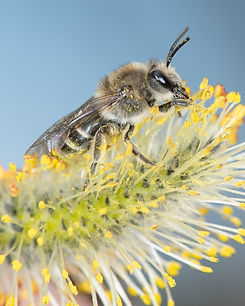
All About Bees > Bee Myths
Bee Myths
Do all bees live in hives and make honey? Do bees sting more than once or die after they sting? I saw a small bee, will it get larger as it ages? Myth-busting answers await!
Hover over the images below to find out the answers!

Moth
No!
Just non-native honey bee females die after stinging. They have a barbed sting; other bees do not.
Moth
No!
In Minnesota, only non-native honey bees produce honey. Native bees do not store honey in their nests.
Moth
No!
Only non-native honey bees nest in hives. Most native bees have solitary nests; a minority have annual eusocial colonies (but not hives).
Moth
No!
The quantity and quality of floral resources (pollen and nectar) a bee consumes as a larva determines the physical size of the adult bee.

Moth
No!
Just female bees can sting; males cannot. In bees, a sting was formerly part of the egg-laying apparatus (ovipositor) but in bees, is now just used for venom injection.
Moth
No!
Only non-native honey bee males (drones) die after mating when their genitalia ruptures from their abdomen, killing them.
Differences Between Honey Bees and Native Bees

Explore Bee Families

Apidae
15 genera, 133 species
Bumble bees Bombus
Longhorn bees
Epimelissodes, Eucera, Melissodes
Carpenter bees
Ceratina, Xylocopa
Honey bees Apis
Digger bees Anthophora
Cuckoo bees Brachymelecta, Epeolus, Holcopasites, Nomada, Neolarra, Triepeolus
Squash bees Xenoglossa

2 genera, 39 species
Halictidae
10 genera, 133 species
Metallic green sweat bees
Agapostemon, Augochlora, Augochlorella, Augochloropsis
Large sweat bees
Dieunomia, Nomia
Short-faced bees Dufourea
Sweat bees Halictus
Small sweat bees Lasioglossum
Cuckoo (blood) bees Sphecodes
Megachilidae
14 genera, 86 species
Resin and pebble bees Anthidiellum, Dianthidium, Heriades, Paranthidium
Carder bees Anthidium, Pseudoanthidium
Mock orange bees Chelostoma
Mason bees Osmia, Hoplitis
Leafcutter bees Megachile
Sharp-tailed cuckoo bees Coelioxys
Dark cuckoo bees Stelis

Citations and Further Reading
Pawelek, J. UC Berkeley Urban Bee Lab. Urban Bee Legends. http://www.helpabee.org/urban-bee-legends.html
Portman, Z. M., Gardner, J., Lane, I. G., Gerjets, N., Petersen, J. D., Ascher, J. S., ... & Cariveau, D. P. (2023). A checklist of the bees (Hymenoptera: Apoidea) of Minnesota. Zootaxa, 5304(1), 1-95.
Page Photography Credits
Heather Holm



